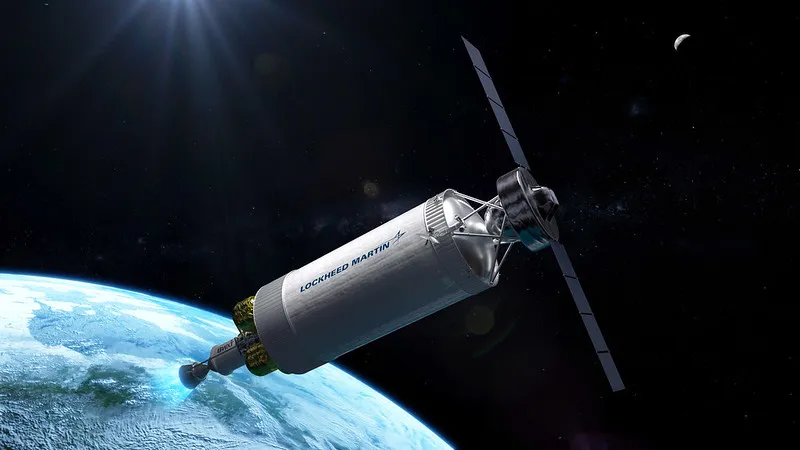The space industry shares a common goal: to overcome terrestrial limits for effective space exploration; to achieve this, innovations in propulsion are key, as they can redefine the landscape of operational efficiency. These innovations have led to the development of new propulsion systems, marking a new era in space exploration.
In the quest to reach not only new destinations, but also to do so more efficiently and sustainably, aerospace engineering has constantly developed new technologies to improve engine thrust. This change not only represents an improvement in travel efficiency, but also represents a crucial step towards more environmentally friendly propulsion models.
Throughout the following article, we will learn about fascinating innovations in aerospace propulsion, exploring how these technologies rewrite the boundaries of cosmic exploration and open the door to future space missions with greater range and efficiency.
Aerospace propulsion evolution
The history of aerospace propulsion is a fascinating chronicle of human ingenuity in overcoming challenges to make this goal a reality. From early rocket experiments to modern space shuttles and beyond, this evolution marks the path of our quest to explore the cosmos.
The technological development towards space exploration began with gunpowder rockets, which had a rather simple, but revolutionary principle of operation for the time. Rockets have been our first window to the speed and power needed to defy Earth’s gravity. Although they were initially used for military and entertainment purposes, their potential became evident.
Robert Goddart was one of the main pioneers of this movement, marking a before and after in terms of propulsion innovations. It was in 1926 when he unveiled the first liquid-fueled rocket. Its launch took place on March 16, 1926, and was considered a transcendental moment by organizations such as NASA1.
In the late 1950s two events of great magnitude took place, the first of which was the launch of the Sputnik 1The first artificial satellite, in 1957, was launched into orbit by the R-7 Semiorka, an intercontinental ballistic missile powered by liquid oxygen and kerosene. The second major milestone would be the arrival of man in outer space, who made this achievement was the cosmonaut Yuri Gagarin in 1961, who boarding the Vostok 1 rocket, achieved a benchmark for new propulsion systems and the design of aerospace engines of the future2.

Man’s arrival in space thanks to propulsion was only one step, since years later, in 1969, the Apollo 11 mission was carried out, which culminated in the conquest of the moon3. To achieve this enormous feat, the Saturn V expendable rocket was needed. This rocket had three stages that used liquid oxygen, as well as refined petroleum (first stage) and liquid hydrogen (second and third stages).
From this point on, NASA has been working hard to improve space exploration. An example of this is the Space Shuttle program, the only vehicle implemented for the transportation of U.S. astronauts during the years 1981-2011, which even had reusable features.
Today’s propulsion innovations are geared towards the search for new propulsion technologies, with the aim of increasingly efficient and sustainable explorations. As a result of this research, innovative concepts such as all-electric propulsion, nuclear propulsion, and even the application of automation in exploration missions have been achieved.
Emerging aerospace propulsion technologies
All-electric propulsion
Among the emerging technologies in aerospace propulsion is all-electric propulsion, an innovative concept that uses electrical forces instead of chemical reactions to generate the thrust needed to mobilize rockets. These aerospace engines of the future make use of electric fields to generate the thrust, unlike conventional systems that are driven by combustion.
The uniqueness of the all-electric drive lies in its outstanding efficiency, allowing the motors to operate continuously for extended periods of time. This attribute positions them as an exceptional tool for deep space exploration missions, making a mark in terms of new propulsion systems, as they pose to challenge the limits of space exploration.
Nuclear propulsion
Nuclear propulsion is an emerging technological concept that promises to improve the process of space travel, offering higher speeds and reduced travel times for interplanetary and, potentially, interstellar missions. This type of propulsion uses nuclear reactions to generate the thrust needed to propel a spacecraft. There are mainly two types of nuclear propulsion under study and development: nuclear thermal propulsion (NTP) and nuclear electric propulsion (NEP).
NTP uses a nuclear reactor to heat a liquid propellant, such as hydrogen, which is then expanded and expelled to generate thrust. This technology promises to be more efficient than conventional chemical propulsion, allowing significantly reduced travel times to destinations such as Mars.
NEP, on the other hand, converts the thermal energy generated by nuclear fission into electricity, which is then used to power electric propellants, providing a continuous and efficient drive, albeit with lower power than NTP, but allowing, in the long term, higher speeds to be achieved.
These technologies, although promising, still face significant challenges in terms of safety, efficiency and economic viability. However, the ongoing research and development effort points to a future where innovations in nuclear propulsion could open new frontiers in space exploration.
Reusable rockets
The reuse of space rockets has marked a shift in the aerospace industry towards sustainability and efficiency. Traditionally, rockets discarded their stages in the ocean or were lost in space, generating waste. However, the initiative driven by companies focused on sustainability and efficiency has changed this picture.
This new practice not only significantly reduces the costs associated with space launches, but also reduces the amount of space debris that has been generated over time, a growing problem given the number of satellites and stations in orbit. The ability to return and land rocket stages for later reuse is a crucial step towards cleaner and more economical space missions, opening up new possibilities for space exploration.
Case Studies: Pioneer Projects
IVO Quantum Drive
The IVO Quantum Drive project represents a significant breakthrough in the field of space propulsion, being the first all-electric thruster. This new concept differs from traditional chemical propulsion methods by using electric fields to accelerate charged particles, thus creating momentum without the need for propellant combustion4.
The development of all-electric aerospace engines would not only improve energy efficiency, allowing prolonged operations with lower fuel consumption, but also facilitate their integration into other machinery such as satellites and spacecraft due to their compact and lightweight design. Although it is a young project, if successful, this technology could optimize access to space, enabling the exploration of distant planets and the construction of human habitats in space, all thanks to these new propulsion systems.
DRACO Project

The DRACO (Demonstration Rocket for Agile Cislunar Operations) project is a pioneering initiative that seeks to revolutionize propulsion in space by developing a nuclear thermal propulsion rocket. Lockheed Martin, in collaboration with BWX Technologies, is leading this effort, which promises to significantly improve the efficiency and speed of space missions5.
This project focuses on the use of a nuclear reactor to heat a hydrogen propellant, generating a powerful and efficient thrust. Benefits include: greater efficiency than conventional chemical propulsion, reduced travel times, and greater ability to carry advanced instruments and supplies. This collaboration combines expertise in aerospace and nuclear technology, respectively, marking a milestone in the history of space exploration.
starship
It is currently one of the most relevant projects in the sector, due to its interesting approach to the reuse of parts. Developed by SpaceX, it is a two-stage vehicle, considered the first to implement full reusability, designed to transport cargo and passengers to locations such as the Moon, Mars, etc6.
As its main objective is to transport people and resources into space, its design aims to be the most powerful rocket ever created. In this way, it is not only a vehicle that operates on the basis of sustainability, but also attempts to take cosmic exploration into new paradigms, thanks to emerging technologies in aerospace propulsion.
Considerations of propulsion innovations
Despite the great benefits of propulsion innovations, there are still factors to consider. In the case of reusable rockets, although they reduce the cost and resources required compared to disposable rockets, they face the challenge of lower payload weight due to the need to incorporate more robust mechanisms to withstand launch and re-entry. In addition, they require extensive reconditioning and testing processes prior to each launch.
On the other hand, nuclear propulsion offers unprecedented energy efficiency, but raises safety concerns, such as the risk of radioactive contamination. Regulatory hurdles, high development costs and technical challenges to ensure reliable operation of reactors in space conditions also represent significant barriers.
In addition, the negative public perception and stigma attached to this type of technology further complicates its implementation. These innovations promise to revolutionize space exploration, but must be approached carefully to mitigate the associated risks.
Conclusions
The evolution of aerospace propulsion represents the history of human ambition. Every technological advance reflects the constant drive to explore, understand and ultimately colonize the cosmos.
The future of aerospace propulsion looks bright, with concepts such as all-electric propulsion and nuclear propulsion no longer just on the minds of scientists, but on the drawing boards. These technologies promise to further accelerate the ability to explore space, and even to the stars.
Innovations in propulsion have played a fundamental role in transforming the world, reality and the understanding of the universe. From gunpowder rockets to the development of advanced aerospace engines, each advance reflects human ingenuity and perseverance. As we look to the future, it is evident that space exploration is just beginning. With each innovation, we get closer to making what was once an impossible dream a reality: living among the stars.
References
- Uri, J. (2021, March 17). 95 Years Ago: Goddard’s First Liquid-Fueled Rocket. Retrieved February 19, 2024, from https://www.nasa.gov/history/95-years-ago-goddards-first-liquid-fueled-rocket/.
- Sadurní, J. (2023, March 7). Yuri Gagarin, the first man in space. Retrieved February 19, 2024, from https://historia.nationalgeographic.com.es/a/yuri-gagarin-el-primer-hombre-en-el-espacio_15169.
- National Air and Space Museum. (sf). Apollo 11. Retrieved February 19, 2024, from https://airandspace.si.edu/about/acerca-del-museo-nacional-del-aire-y-el-espacio/apolo-11.
- MasScience. (2023, April 4). The IVO Quantum Drive: the electric revolution in space propulsion. Retrieved February 20, 2024, from https://www.masscience.com/el-ivo-quantum-drive-la-revolucion-electrica-en-la-propulsion-espacial/.
- Lockheed Martin. (2023, July 26). Lockheed Martin Selected To Develop Nuclear-Powered Spacecraft. Retrieved February 20, 2024, from https://news.lockheedmartin.com/2023-07-26-Lockheed-Martin-Selected-to-Develop-Nuclear-Powered-Spacecraft.
- SpaceX. (sf). Starship. Retrieved February 20, 2024, from https://www.spacex.com/vehicles/starship.

